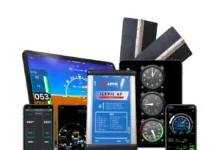
I just got back from a test flight with TruTrak Flight Systems‘ Andrew Barker in their company’s RV-10. The purpose – to get a chance to fly their latest autopilot, the ECO. Now most of the time, when a new avionics box is announced, it increases the total number of features over previous products – but in this case, less is more. And that “less” includes the price. Targeted to cost right at $1,000, the ECO does just a few things – and does them very well. It will hold a heading, track the NAV source, and hold altitude – That makes it a useful, but simple, autopilot. Most of the time, who actually needs more on a VFR cross-country? (If you want to automatically do a teardrop entry to a hold while descending and capturing a new altitude, TruTrak will be glad to sell you one of their more capable units.)

But this box does more than just provide an autopilot. Barker is a firm believer in doing something to decrease the number of accidents caused by loss of control – pilots simple getting outside of their comfort zone or envelope. The ECO is designed to provide full-time envelope protection – basically, it helps warn the pilot of over-banking or getting into a high or low pitch situation. Remember when you first flew with an instructor, and they might have given you a little help by keeping two fingers on the stick, adding just a touch of pressure to nudge you back in the right direction? This is exactly what the Eco does – providing a little restoring effort to the controls when it senses the pilot flying outside of a defined attitude box.
The ECO is very different from most current autopilots because it uses small high-quality R/C servos and piano-hinge trim tabs to “fly” the control surfaces, rather than moving control cables and pushrods directly. The control head fits a 2 ¼” gauge hole and is about an inch thick. It needs power and ground, plus a serial GPS input. Three wires go to each servo, and the servos can be embedded in the control surface, or mounted externally. This is a simple add-on to an existing plane.
How does it fly? Remarkably well. In fact, it was hard to tell the difference between it and the much more sophisticated Sorcerer that was also installed in the airplane. What I found most interesting was the envelope protection. Because the autopilot is flying a trim tab, when it “suggests” that maybe you’re getting too steep in your turn, it pushes back on the stick simply by driving the airplane “out if trim” – this is a much more comfortable feeling than having a standard autopilot servo pushing directly on the controls. I flew a fairly steep military 8 (much to the chagrin of the envelope protection), and it just felt like I needed to re-trim the airplane – it was easy to do what I wanted regardless of the autopilot’s insistence that we return to normal flight, but it was also apparent that I was outside the envelope.
The ECO will be the subject of a full review in a coming issue of Kitplanes, and we look forward to TruTrak getting them in the hands of customers in the near future.













